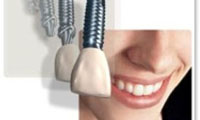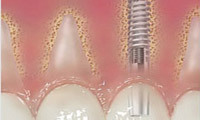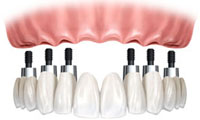Dental implantation
A modern, aesthetic solution for dental replacement
What is a tooth implant?
An implant, also called a “false root”, is set into the place of the lost tooth in the jaw bone by a surgical procedure. These top quality implants make up a new and permanent dental replacement structure, which is just as strong and firm as your original tooth.
What are the implants made of?
Today, following the international quality standard, dental implants are made of titanium, which is a tissue friendly metal. It does not cause damage or corrode; it is acid-resistant and is resistant to other materials as well. It is not magnetized and it is very strong compared to its weight.
Who can get an implant?
Tooth implants are normally based on age. Dental implants require good health and the chin bone has to have the proper quantity and quality of bone substance. In case of high agnathia (lack of bone), there is a chance of building a bone. In this case we use artificial bone materials, as well as the patient’s bone. During the preliminary examinations the dentist informs the patient about the process of the treatments, the surgical procedures, and the planning of the tooth replacement.
What are the advantages of implantation?
- with the help of implantation, tooth replacement can be managed without buffing the neighbouring and healthy teeth.
- unlike removable tooth replacements, a fixed and permanent replacement is created (with the proper quantity of implants).
- a firm, stable tooth effects your pronunciation in a positive way, providing a better quality of life and giving you more confidence.
- another advantage of implants is that they prevent bone decomposition, which is unavoidable after teeth loss.
- the physic pressure caused by removable replacements can completely cease.
- the implant last between 10 to 20 years, depending on the place of the implant and the patient’s oral hygiene.
How does the implantation happen?
The procedure is performed by oral surgeons and implant specialists with many years of practice and experience. They use local anaesthesia. The implantation is like a small operation.
The specialist first takes an X-ray to determine exactly where to place the implant. After local anaesthesia the surgeon lances (opens up) the gingiva (gum) and then drills a hole in the chin bone, where the implant is placed. Afterwards the professional surgically sutures (stitches) the gums. If no more than one tooth is involved, the treatment only takes an hour. After the procedure is finished, the patient receives pain medication. The sutures are removed a week after the operation.
The recovery time takes between 1-3-6 months. The procedure continues with the preparation of the dental superstructure (bridge, crown or denture) or in the case of adequate bone-supply, the temporary prosthesis can be immediately prepared and placed onto the new implants, so the patient can leave the dental clinic that day or the following day with perfectly functioning teeth.
When will I have my new teeth?
You have to wait a couple months until the implant ossificates (heals with bone material ossificating with its environment), meaning that the bone grows on and around the implant, creating a firm position. This means 3-4 months in both the upper and lower jaw bone. The implant heals with the gum covering it. The second operation can only be performed after a full recovery. The tooth replacement (bridge, crown, denture) can also only be prepared and attached after a full recovery.
But until then, the patient does not have to suffer without teeth because if the implant is placed in the front place of the mouth, the dentist uses a temporary denture or bridge made especially for the patient. If your teeth are all made of dental prosthesis, you can wear it during the whole period of recovery after it has been transformed.
Crowns
A dental crown is a tooth-shaped “cap”, which is placed on the root of the remaining premedicated tooth, strengthening it and creating the original shape and colour of the tooth.
The crowns are made in dental laboratories. They can be made completely of metal, ceramic with a metal base, precious metal, or completely of ceramic.
The patient must visit the dentist at least two or three times during the treatment. The first appointment includes the preparation by taking the imprint, choosing the colour and putting on the temporary crown. At the second and third appointments, the patient tries on the final crown and it is glued into place. The appointments usually require 1-2 weeks.
The life span of a crown is 8 years, but most of the time they last much longer, up to 40 years.
Metallic Ceramic Crown
A metal cap is poured on the ground tooth which is then covered with tooth coloured ceramic. This ceramic completely hides the metal, making it look aesthetically pleasing. Producing the metal cap from any precious metal complies with the strictest standards of biocompatibility and aesthetics. These crowns are stable and long-lasting; the ceramic crown cover is colour-fast and offers a high aesthetic value.
Metal-free ceramic crown
If the ground tooth is not given a metal cap but is completely made of ceramic, then it is referred to as metal-free or all ceramic crown. As no metal is present and ceramic itself is highly permeable to light, it conforms to high aesthetic standards. Today, this is the most aesthetic prosthesis.
Electroplated gold crown
It is possible to use the traditional pouring method as well as the so-called gold electroplating to prepare a metal cap on the ground tooth root. This produces an extremely thin (only 0.2 mm) cap made from pure gold which is covered with ceramic. The crowns prepared in this way are outstanding and precise. The yellow golden base provides a lively colour and effect.
Bridges
Bridges are used if only a few teeth need to be replaced, or if we are dealing with an sufficient amount of abutments or a part of a tooth can be replaced with implants.
A bridge is a dental prosthesis which fixes the replacement dentures (false teeth) to the adjacent remaining ones. Crowns with a ceramic cover always have a metal base called a metal structure. It can be made from precious metals (the most precise) or non-precious metals. The ceramic cover sits on the metal base making it look aesthetically pleasing. The metal structure gives the bridge its stability and long life.
Dentures
There are two types of dentures: the full denture and the partial denture. The full denture replaces all the teeth of the upper or lower jaw. The partial denture replaces the missing teeth. This is secured to a metal-frame, and it adjusts itself to the natural teeth with metal clips (precise elements). In some cases crowns are placed on the patient’s own teeth, which secure the denture as an anchor. Your dentist will help you choose the most suitable denture (tooth replacement) for you.
What are the dentures made of?
The denture is personalized and prepared in the dental laboratory based on the mould taken of the patient’s dental imprint. Its base is a flesh-coloured plastic, which modifies itself with the patient’s gums. The upper denture covers the palate and the lower denture is horse-shoe shaped. The framework can also be made of metal. The teeth are generally made of plastic and match the colour of the natural teeth, which is especially important in cases of a partial denture.







